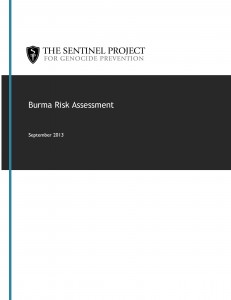Burma Risk Assessment
By The Sentinel Project for Genocide Prevention • September 11, 2013 Following extensive research, the Sentinel Project has concluded that the risk of genocide or related mass atrocities in Burma is extremely high. Despite recent democratic reforms in the country, violence, discrimination, and extrajudicial killings continue and are mostly directed toward the Muslim Rohingya minority in Rakhine state. Violence and other crimes against the Rohingya, which are conducted by both state and non-state groups, are both widespread and systematic.
Following extensive research, the Sentinel Project has concluded that the risk of genocide or related mass atrocities in Burma is extremely high. Despite recent democratic reforms in the country, violence, discrimination, and extrajudicial killings continue and are mostly directed toward the Muslim Rohingya minority in Rakhine state. Violence and other crimes against the Rohingya, which are conducted by both state and non-state groups, are both widespread and systematic.
Confidential and open-source evidence has revealed that, contrary to government statements and most media reporting, inter-ethnic violence is not merely communal or criminal in nature, but is part of a state-sponsored campaign of ethnic cleansing with the distinct possibility of genocide carried out either through extermination by killing squads or more slowly by isolation and starvation. While virtually all of the elements of the genocidal process are present in Burma, it is too early to determine whether genocide itself is currently occurring. Such a determination depends upon both the continued systematic ethnic cleansing of Muslim-populated regions and upon continued isolation, denial of aid, and restriction of movement, which could be interpreted as indicators of genocidal intent. Currently, upwards of 110,000 Rohingya are housed in internally displaced persons (IDP) camps, which represents one eighth of the estimated Rohingya population of Burma.
Of the multiple signs of an impending genocide crisis, the Sentinel Project is particularly concerned by the following evidence:
- Continued periodic outbreaks of organized violence, regularly accompanied by either inaction or participation by government security forces, and agents provocateurs of unknown government affiliation;
- An attempt by local governments within Rakhine to limit Rohingya reproduction by enforcing a two-child limit;
- A proposed ban on interfaith marriage is supported by extreme nationalist Buddhist monks and is being considered as legislation;
- The continued denial of aid to squalid camps and continuing movement restrictions, expropriation, displacement, and ghettoization of Rohingya;
- An attempt to perform a census of Rohingya, violently coercing them to register as “Bengali,” which may facilitate the creation of “death lists”;
- The continuing arrest of political prisoners despite presidential assurances to the contrary;
- Official government support for the ultra-nationalist 969 movement, which alienates Muslims and casts them as a threat;
- Burmese president Thein Sein’s proposed plan to resettle the Rohingya population abroad;
- Thein Sein’s proclamation to continue denying citizenship to the Rohingya;
- The official denial of the existence of the Rohingya and institutionalized usage of hate speech even among moderates; and
- The silence of political moderates on the plight of the Rohingya.
If Gregory Stanton’s rubric of a staged model of genocide is applied to Burma, a “genocide emergency” must now be declared and the options for intervention are limited. At the international, state-focused level, United Nations Security Council must be mobilized and heavy assistance must be provided to the Rohingya in preparation for their self-defense. Since humanitarian assistance is denied in Burma, preparations must be made for the continuing outflow of refugees. Refugee camps in bordering countries are already overcrowded and in poor condition with Thailand and Bangladesh receiving most of the people fleeing the violence.
This post is in: Crimes Against Humanity, Spotlight
Related PostsMyanmar: Free Prisoners of Conscience in Rakhine State End Ongoing Persecution of Rohingya
UN Myanmar Rights Expert: Backtracking on Democratic Space Gains Momentum in Election Year
Myanmar’s Proposed Race and Religion Laws are Discriminatory and should be Scrapped
The FCO’s Human Rights Work 2013
BROUK Welcomes US Senate Resolution on Rohingya









 All posts
All posts